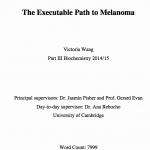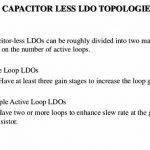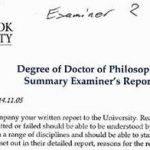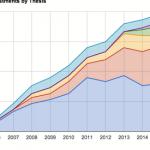1. Problem. The methodology typically follows your literature review, so for the purposes of clarity and regaining focus it is useful briefly to recap the central research questions of your dissertation. Define and explain the problems which you seek to address.
2. Approach. Give an overview of your approach to primary research in order to guide the reader and contextualise your methodology. By identifying all methodological aspects to which to will attend – rationale, justification, sampling issues, etc. – you can signal unambiguously to the reader that you fully understand the implications of thorough, astute methodology.
3. Reproducibility. The ability to reproduce the results of an experiment is a hallmark of proper scientific method; in the humanities also, reproducibility indicates greater credibility and usefulness. Provide a detailed description of your techniques, such that those wishing to challenge your position could, if they wished, reproduce the same research.
4. Precedence. Consider whether your research methodology is typical of comparable research projects within your particular subject area. A review of the relevant literature will doubtless find some comparable endeavours, in which case the adoption of those methodologies may lend authority to your approach.
5. Justification. It is absolutely essential that you provide sound reasons for the methods your have chosen to conduct your research. This aspect is particularly important when adopting a novel or non-standard methodology. Approaches at odds with comparable endeavours require considerable rigorous justification.
6. Rationale. No matter what type of research, there is almost always a number of methodological approaches available.
In your rationale, critically evaluate alternate approaches in order to defend the methods you have finally chosen. Weigh up the pros and cons of all relevant alternatives, including your own choice.
7. Reliability and validity. Essential considerations in all types of research, issues of reliability and validity must be explicitly discussed. Many matters fall under this area, including accuracy, precision, sources of error and statistical significance.
8. Sampling. Questions concerning sampling techniques and sample size can be considered under reliability and validity, but are often important enough to be given special attention. The impact of sample size upon statistical significance of your results is an issue of such importance that you should be mindful of this when designing and writing up your methodology.
9. Appendix. Keep your methodology chapter focussed and lucidly written by appending indirectly relevant material to the end of your dissertation writing. Copies of questionnaires and other methodological material should usually be placed in the appendix.
10. Generalisation. Include a section in your methodology which directly addresses the question of how far data obtained through your approach can be generalised. Bear this issue in mind when designing your methodology too, as results with general significance outside of your direct data set will tend to increase the persuasiveness of your eventual findings.
Contents
1 Introduction
Learning goals
- Understand that a master thesis is an argument
- Learn how to sequence a thesis
- Understand that you may have to respect certain standards
Prerequisites
- Methodology tutorial – the research plan
- Most other methodology tutorials in one way or another.
Moving on
- Do other research :)
Level and target population
- Beginners – master thesis
Quality
- Should be ok, although important elements are missing regarding the principal chapters
In other words: The organization of the written theses has nothing to do with the organization of the research plan or its little section on planning. In particular:
- A research plan (i.e. the research design) defines and organizes your work according to logical criteria.
- The research planning (i.e. the little section at the end of your research plan) organizes your time according to workpackages and deliverables.
- Research is just done and not told, i.e. you do not tell people your personal experience with this. The thesis is not a story. It presents the results of your research (including a literature review and and methodological explanation on how you did it). There may exist exceptions, e.g. in some forms of ethnography.
The structure of your thesis if defined by two main elements:
- The research type/approach and related methodological criteria.
- Some rhetorical principles, i.e. your thesis should be readable.
A reader must understand your objectives, the theorectical background, the questions, how you did it and your answers (results).
2 Presentation and typographic structure
Let’s first a look at some superficial presentation issues.
2.1 The word processor
Start by admitting that you don’t know how to use a word processor. Don’t feel ashamed. Most people don’t. E.g. I had to write a wiki entry about Microsoft Word before writing a larger text. I usually use FrameMaker which is very different because it was designed for people that write real text and I had to make a real effort to adapt to MS Word. – Daniel K. Schneider
Here is a list of “must know” things:
- Define styles (and make sure to configure MS Word that will inhibit modifications on fly them or addition of new styles)
- Automatically create tables of contents and figures
- Create indexes
- Automatically number titles
- Create stable numbered lists
There exist two “formatting” strategies
- Either learn how to create a good list of styles (you may need between 15 and 30 for a master thesis depending on your research type
- Ignore my advice, but then only spend your last day with manual formatting.
Professionals do it this way
- Each type of paragraph has its own style
- Never use TABS or empty lines (e.g. paragraphs are separated by space, not an empty line, so add horizontal space to the paragraph style element definition).
Your list of styles
You need at least the following elements:
- Numbered Chapter, numbered section, numbered sub-section and unnumbered sub-section. If you use MS Word, just define styles for heading 1 to heading 4.
- List elements (bullet list items and enumerated items). You may, but usually don’t have to define these at two levels
- Normal paragraphs
- Citation paragraphs (indented)
- A style for fixed formats if you plan to present code
- One ore more good table styles
- Figure captions
Tip: Read Microsoft Word for some advice.
2.2 Titles et sections
Here is some advice about titles and sections
The table of contents not only is a navigation tool but it indirectly defines your argumentation flow. This is why wording of titles and structure is important.
Do not use too many section levels (like 12.3.4.1.a). Your thesis is not a military or administrative operations manual, but a flow of connected ideas.
- Too many levels will make orientation difficult for the reader. He won’t understand where he is.
- You may add unnumbered titles at the section or sub-section level or maybe use something like (a). (1).
- Each numbered sub-section represents an important topic
- Titles should summarize a topic (without being too long)
You have to find a compromise between:
- flow of argumentation (avoid sub-titles because the “cut” intro a text)
- structure (use sub-titles to separate topics)
- readability (use un-numbered sub-titles to structure contents that stretch over several pages)
2.3 Layout
There exist several schools of thought. Make sure to consult official guidelines too !
Either just number from 0 to n or use the more sophisticate following scheme:
- Roman numbers for preface, table of contents etc.
- Normal (arabic) numbers for the main part
- Something like A-1, etc. for annexes.
Headers and footers
- On top of left pages you should put the current chapter title
- On top of right pages you should put the current section title
- On bottom right (and if you use left/right pages, also on bottom left) include the page number. Make sure to do this for early drafts too. I hate students that present drafts without table of contents and numbered pages and your advisor will hate you too – Daniel K. Schneider .
Notice: In MS Word 2003 adding chapter headings is painstaking labour since you have to do this for each section, so you may skip this. But any real word processor can do this really easily.
Line length
- Don’t write long lines ! Readers will get lost
- Simply use decent margins and don’t use small fonts (10pt is too small)
- You may indent titles to the left (certainly not to the right as some Word default styles will do)
Some “modern additions”
- Use boxes to present “special information” like case summaries or important conclusions.
- Use side headers (also very difficult to do in Word 2003).
Figures an tables
- Label and number each of these. If you work with a real word processor, let them float to the top or the bottom of the page. If you use Word, you can do this manually (but only the day before you turn it in).
Fonts
- Use a font with serifs (e.g. Palatino or Times Roman)
- Non serif fonts may look prettier to you, but they diminuish readability since serif fonts add some “invisible line” that the reader’s brain will use to keep track.
3 The organization of a thesis
Here are the most important parts of an academic piece:
You may use it to:
- thank people and tell them how much you like your cat
- explain why you have chosen this subject
- (maybe) excuse yourself for things to didn’t do
- announce some followup
Tip: Give some thanks to your advisor. He/she probably deserves it and even if he/she doesn’t, it’s good policy.
3.2 Table of contents of tables and figures
- Position: At start and after the foreword
- Must match titles in the text (this should be obvious). Even Word can generate this easily.
- You also should add tables for the figures and the tables. This will allow people finding synthetic information.
Do not forget that you don’t just write a thesis for a jury. Other people may read it and they want to do this fast and maybe just find some bit of information as quickly as possible.
3.3 Abstract
- This is often mandatory
- If it is not, you also may summarize your thesis as a paragraph in the introduction
3.4 Introduction
The introduction (as well as the conclusion) is the most important chapter of your thesis. Some people will decide to read or not to read your thesis after looking at the first page.
- Even serious readers like the jury, will read the introduction first and they should clearly understand what you did. Also make sure that they find your subject interesting. You have to frame readers.
This section describes the main elements of a written thesis at the bachelor’s and master’s levels. Although the specific structure described here is most relevant for empirical theses, much of the advice is also relevant for theoretical work. Please note that the formal requirements vary between different disciplines, and make sure to confer the guidelines that apply in your field.
For the contents in the various sections you may also confer Organising your writing.
Abstract and foreword
Most readers will turn first to the abstract. Use it as an opportunity to spur the reader’s interest. The abstract should summarise the main contents of your thesis, especially the thesis statement, but does not need to cover every aspect of the main text. The main objective is to give the reader a good idea of what the thesis is about.
In general the abstract should be the last thing that you write, when you know what you have actually written. It is nevertheless a good idea to work on a draft continuously. Writing a good abstract is difficult, since it should only include the most important points of your work. But this is also why working on your abstract can be useful – it forces you to identify exactly what it is you are writing about.
There are usually no formal requirements for forewords, but it is common practice to thank your supervisors, informants, and others who have helped and supported you. If you have received any grants or research residencies, you should also acknowledge these.
Note: Shorter assignments do not require abstracts and forewords.
1. Introduction
Your introduction has two main purposes: 1) to give an overview of the main points of your thesis; and 2) awaken the reader’s interest. It’s not a bad idea to go through the introduction one last time when the writing is done, to ensure that it connects well with your conclusion.
Tip: For a nice, stylistic twist you can reuse a theme from the introduction in your conclusion. For example, you might present a particular scenario in one way in your introduction, and then return to it in your conclusion from a different – richer or contrasting – perspective.
Your introduction should include:
- The background for your choice of theme
- A discussion of your research question or thesis statement
- A schematic outline of the remainder of your thesis
The sections below discuss each of these elements in turn.
1.1 Background
The background sets the general tone for your thesis. It should make a good impression and convince the reader why the theme is important and your approach relevant. Even so, it should be no longer than necessary.
What is considered a relevant background depends on your field and its traditions. Background information might be historical in nature, or it might refer to previous research or practical considerations. You can also focus on a specific text, thinker or problem.
Academic writing often means having a discussion with yourself (or some imagined opponent). To open your discussion, there are several options available. You may, for example:
- refer to a contemporary event
- outline a specific problem; a case study or an example
- review the relevant research/literature to demonstrate the need for this particular type of research
If it is common in your discipline to reflect upon your experiences as a practitioner, this is the place to present them. In the remainder of your thesis, this kind of information should be avoided, particularly if it has not been collected systematically.
Tip: Do not spend too much time on your background and opening remarks before you have gotten started with the main text.
Exercise
Write three different opening paragraphs for your thesis using different literary devices
For example:
a) “set the scene” with a (short) narrative
b) adopt a historical approach to the phenomenon you intend to discuss
c) take an example from the media to give your topic current relevance.
Observe to what extent these different openings inspire you, and choose the approach most appropriate to your topic. For example, do you want to spur emotions, or remain as neutral as possible? How important is the historical background? The exercise can be done in small groups or pairs. Discuss what makes an opening paragraph successful (or not). How does your opening paragraph shed light on what is to follow? What will the reader’s expectations be?
1.2 Defining the scope of your thesis
One of the first tasks of a researcher is defining the scope of a study, i.e. its area (theme, field) and the amount of information to be included. Narrowing the scope of your thesis can be time-consuming. Paradoxically, the more you limit the scope, the more interesting it becomes. This is because a narrower scope lets you clarify the problem and study it at greater depth, whereas very broad research questions only allow a superficial treatment.
The research question can be formulated as one main question with (a few) more specific sub-questions or in the form of a hypothesis that will be tested.
Your research question will be your guide as your writing proceeds. If you are working independently, you are also free to modify it as you go along.
How do you know that you have drafted a research question? Most importantly, a research question is something that can be answered . If not, you have probably come up with a theme or field, not a question.
- Use interrogative words: how, why, which (factors/situations) etc.
- Some questions are closed and only invoke concrete/limited answers. Others will open up for discussions and different interpretations.
Asking “What &…?” is a more closed question than asking “How?” or “In what way?”
Asking “Why” means you are investigating what causes of a phenomenon. Studying causality is methodologically demanding. - Feel free to pose partially open questions that allow discussions of the overall theme, e.g. “In what way &…?”; “How can we understand [a particular phenomenon]?”
- Try to condense your research question into one general question – and perhaps a few more specific sub-questions (two or three will usually suffice).
1.3 Outline
The outline gives an overview of the main points of your thesis. It clarifies the structure of your thesis and helps you find the correct focus for your work. The outline can also be used in supervision sessions, especially in the beginning. You might find that you need to restructure your thesis. Working on your outline can then be a good way of making sense of the necessary changes. A good outline shows how the different parts relate to each other, and is a useful guide for the reader .
It often makes sense to put the outline at the end of the introduction, but this rule is not set in stone. Use discretion: What is most helpful for the reader? The information should come at the right point – not too early and not too late.
2. Theory section
The theory used in an empirical study is meant to shed light on the data in a scholarly or scientific manner. It should give insights not achievable by ordinary, everyday reflections. The main purpose of using theory is to analyse and interpret your data. Therefore, you should not present theoretical perspectives that are not being put to use. Doing so will create false expectations, and suggests that your work is incomplete.
Not all theses have a separate theory section. In the IMRaD format the theory section is included in the introduction, and the second chapter covers the methods used.
What kind of theory should you choose? Since the theory is the foundation for your data analysis it can be useful to select a theory that lets you distinguish between, and categorise different phenomena. Other theories let you develop the various nuances of a phenomenon. In other words, you have a choice of either reducing the complexity of your data or expanding upon something that initially looks simple.
How much time and space should you devote to the theory chapter? This is a difficult question. Some theses dwell too long on theory and never get to the main point: the analysis and discussion. But it is also important to have read enough theory to know what to look for when collecting data. The nature of your research should decide: Some studies do not require much theory, but put more emphasis on the method, while other studies need a rich theory section to enable an interesting discussion.
3. Method section
In a scholarly research article, the section dealing with method is very important. The same applies to an empirical thesis. For students, this can be a difficult section to write, especially since its purpose may not always be clear.
The method chapter should not iterate the contents of methodology handbooks. For example, if you have carried out interviews, you do not need to list all the different types of research interview. You also do not need to describe the differences between quantitative and qualitative methods, or list all different kinds of validity and reliability.
What you must do is to show how your choice of design and research method is suited to answering your research question(s). Demonstrate that you have given due consideration to the validity and reliability of your chosen method. By &”showing&” instead of &”telling&”, you demonstrate that you have understood the practical meaning of these concepts. This way, the method section is not only able to tie the different parts of your thesis together, it also becomes interesting to read!
- Show the reader what you have done in your study, and explain why. How did you collect the data? Which options became available through your chosen approach?
- What were your working conditions? What considerations did you have to balance?
- Tell the reader what you did to increase the validity of your research. E.g. what can you say about the reliability in data collection? How do you know that you have actually investigated what you intended to investigate? What conclusions can be drawn on this basis? Which conclusions are certain and which are more tentative? Can your results be applied in other areas? Can you generalise? If so, why? If not, why not?
- You should aim to describe weaknesses as well as strengths. An excellent thesis distinguishes itself by defending – and at the same time criticising – the choices made.
4. Analysis
Your analysis, along with your discussion, will form the high light of your thesis. In the IMRaD format, this section is titled “Results”. This is where you report your findings and present them in a systematic manner. The expectations of the reader have been built up through the other chapters, make sure you fulfill these expectations.
To analyse means to distinguish between different types of phenomena – similar from different. Importantly, by distinguishing between different phenomena, your theory is put to work. Precisely how your analysis should appear, however, is a methodological question. Finding out how best to organise and present your findings may take some time. A good place to look for examples and inspiration is repositories for master’s theses.
If you are analysing human actions, you may want to engage the reader’s emotions. In this case it will be important to choose analytical categories that correlate to your chosen theory. Engaging emotions is not the main point, but a way to elucidate the phenomenon so that the reader understands it in a new and better way.
Note. Not all theses include a separate chapter for analysis.
5. Discussion
In many thesis the discussion is the most important section. Make sure that you allocate enough time and space for a good discussion. This is your opportunity to show that you have understood the significance of your findings and that you are capable of applying theory in an independent manner.
The discussion will consist of argumentation. In other words, you investigate a phenomenon from several different perspectives. To discuss means to question your findings, and to consider different interpretations. Here are a few examples of formulations that signal argumentation:
- On the one hand &… and on the other
- But is it really true that&…
- &… on can it also be supposed&…?
- &… another possible explanation may be &…
6. Conclusion or summing up?
The final section of your thesis may take one of several different forms. Some theses need a conclusion, while for others a summing up will be appropriate. The decisive factor will be the nature of your thesis statement and research question.
Open research questions cannot always be answered, but if a definite answer is possible, you must provide a conclusion. The conclusion should answer your research question(s). Remember that a negative conclusion is also valid.
A summing up should repeat the most important issues raised in your thesis (particularly in the discussion), although preferably stated in a (slightly) different way. For example, you could frame the issues within a wider context.
Placing your thesis in perspective
In the final section you should place your work in a wider, academic perspective and determine any unresolved questions. During the work, you may have encountered new research questions and interesting literature which could have been followed up. At this point, you may point out these possible developments, while making it clear for the reader that they were beyond the framework of your current project.
- Briefly discuss your results through a different perspective. This will allow you to see aspects that were not apparent to you at the project preparation stage
- Highlight alternative research questions that you have found in the source materials used in the project
- Show how others have placed the subject area in a wider context
- If others have drawn different conclusions from yours, this will provide you with ideas of new ways to view the research question
- Describe any unanswered aspects of your project
- Specify potential follow up and new projects
A thesis should “bite itself in the tail”
There should be a strong connection between your conclusion and your introduction. All the themes and issues that you raised in your introduction must be referred to again in one way or another. If you find out at this stage that your thesis has not tackled an issue that you raised in the introduction, you should go back to the introduction and delete the reference to that issue. An elegant way to structure the text is to use the same textual figure or case in the beginning as well as in the end. When the figure returns in the final section, it will have taken on a new and richer meaning through the insights you have encountered, created in the process of writing.
J. Schimel, 2012 Writing Science. How to write papers that get cited and proposals that get funded. New York: Oxford University Press





 American dragon jake long professor rotwoods thesis proposal
American dragon jake long professor rotwoods thesis proposal Capacitor less ldo thesis writing
Capacitor less ldo thesis writing Examiners report of phd thesis writing
Examiners report of phd thesis writing Stefanos sidiropoulos phd thesis proposal
Stefanos sidiropoulos phd thesis proposal Union square ventures thesis proposal
Union square ventures thesis proposal






